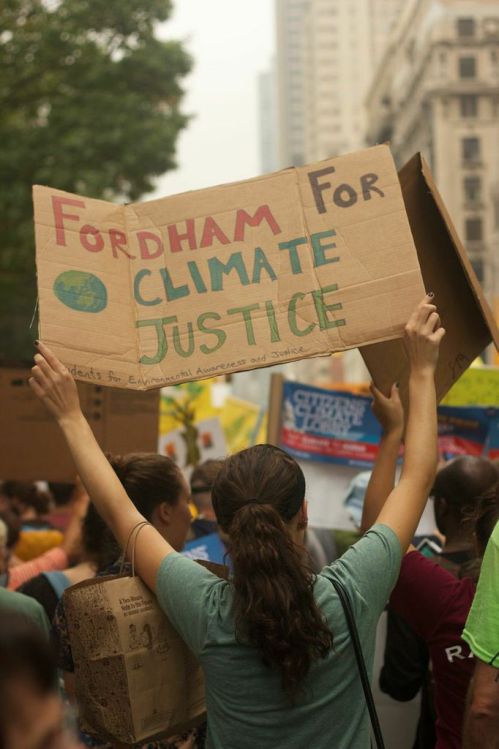
The People’s Climate March sought to catch the attention of the United Nations. (Courtesy of Samantha Mandichi)
By Samantha Franco
_____________________________________________
Over 400,000 people from across the nation assembled on Central Park West on Sunday for the People’s Climate March in New York City, hoping to catch the attention of United Nations leaders before they debated on environmental action at the United Nations climate summit on Tuesday.
The march was divided into six broad categories that each included an array of groups. At the forefront, indigenous peoples led the way for the multitude of marchers. Then followed students, labor unions, parents and children, political organizations, veterans, peace and justice groups, scientists, faith communities and LGBTQ groups, to name a few of the many types of people who came to support climate action.
Fordham’s own Students for Environmental Awareness and Justice (SEAJ) club gathered a group of students to attend the march. Even professors, including Fordham Communications professor, Christopher Brandt, took time out of their day off to fight for climate change.
“I went, like so many others, in frustration at the craven fealty of our ‘leaders’ to the corporate will…or lack of will. But I also held the belief that we the people are the only agents with the knowledge, the will and the courage, and that we, acting together can raise the consciousness of the human race. Consciousness raised, we can act decisively and intelligently, the ‘leaders’ and the corporate will be damned,” says Brandt.
“I was a peacekeeper, with the orange t-shirt and the white ball cap. Nothing to do but give directions, the peace kept itself,” he added.
Protests, however, did not end with the Climate March. On Monday, 2,000 protesters gathered for an event they called “Flood Wall Street” near Battery Park to conduct a peaceful sit in on Wall Street. The activists only got as far as Broadway before they were met with police barricades. Still, they did manage to block off traffic for eight hours. An estimated 100 people were arrested throughout the day because the event did not have a permit from the New York Police Department allowing a demonstration to take place.
Environmental activists protested on Sunday, risking arrest in hopes to get their voices heard by world leaders who debated on issues such as how to reduce gas emissions in order to maintain a sustainable planet.
“I believe we are perilously close to a point of no return on the a-ymptotic curve of climate change — very slow for quite a long time, then the curve sharpens, and in no time its trajectory reaches speeds impossible to stop,” said Brandt.
If new legislation concerning climate action were to be passed, it would strengthen Fordham’s already existing environmental policies. The university has in effect a Climate Action Plan (CAP) in partnership with the New York City Mayor’s Office. Its goal is “for all the Fordham campuses to reduce its carbon emissions by 30 percent by 2017” in a wide range of areas including energy, recycling, building construction, transportation, education and collaborations. The plan is an acceptance of Mayor Michael Bloomberg’s challenge called PlaNYC to “reduce university’s carbon dioxide footprints over the next decade.”
Brandt hopes that “[new legislation] would be strong enough to serve as a wakeup call, that Fordham and all universities would take seriously their mission as not the keepers but the disseminators of knowledge and leaders rather than followers in thought. Perhaps they will become less conventionally servile and passive and become centers of action as well as study and contemplation. And most certainly they would stop acting like corporations and find a new way to organize themselves.”



With 60 BILLION food animals on the planet, this should be our first step in the Climate March!
http://meatonomics.com/
“As environmental science has advanced, it has become apparent that the human appetite for animal flesh is a driving force behind virtually every major category of environmental damage now threatening the human future: deforestation, erosion, fresh water scarcity, air and water pollution, climate change, biodiversity loss, social injustice, the destabilization of communities, and the spread of disease.” Worldwatch Institute, “Is Meat Sustainable?”
“If every American skipped one meal of chicken per week and substituted vegetables and grains… the carbon dioxide savings would be the same as taking more than half a million cars off of U.S. roads.” Environmental Defense Fund
“A 1% reduction in world-wide meat intake has the same benefit as a three trillion-dollar investment in solar energy.” ~ Chris Mentzel, CEO of Clean Energy
There is one single industry destroying the planet more than any other. But no one wants to talk about it… http://cowspiracy.com
Step by Step Guide: How to Transition to a Vegan Diet http://www.onegreenplanet.org/vegan-food/step-by-step-guide-how-to-transition-to-vegan-diet/